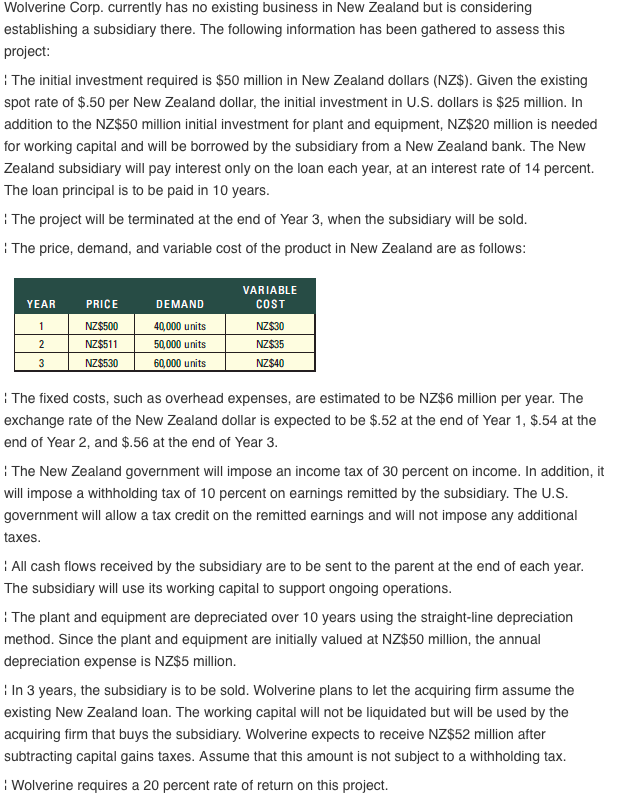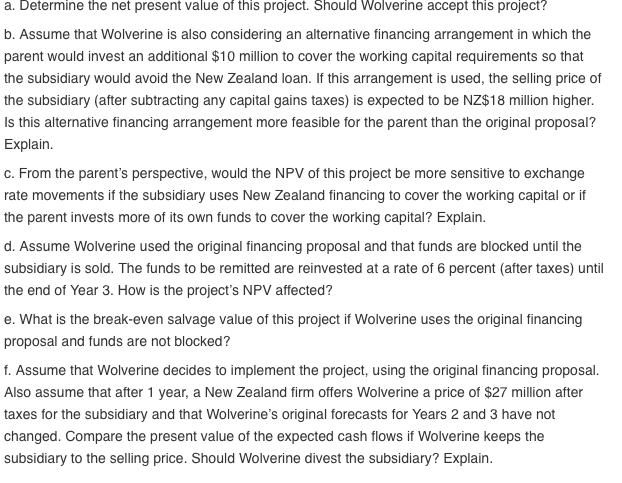From the International Financial Management (12th Edition) textbook, could someone please answer question number 27 (A, B, C, D, E, and F with all the steps) in chapter 14
.

Wolverine Corp. currently has no existing business in New Zealand but is considering establishing a subsidiary there. The following information has been gathered to assess this project The initial investment required is $50 million in New Zealand dollars (NZ$). Given the existing spot rate of $.50 per New Zealand dollar, the initial investment in U.S. dollars is $25 million. In addition to the NZ$50 million initial investment for plant and equipment, NZ$20 million is needed for working capital and will be borrowed by the subsidiary from a New Zealand bank. The New Zealand subsidiary will pay interest only on the loan each year, at an interest rate of 14 percent. The loan principal is to be paid in 10 years The project will be terminated at the end of Year 3, when the subsidiary will be sold The price, demand, and variable cost of the product in New Zealand are as follows PRICE NZ$500 NZ$511 NZ$530 VARIABLE COST NZ$30 NZ$35 NZ$40 YEAR DEMAND 40,000 units 50,000 units 60,000 units The fixed costs, such as overhead expenses, are estimated to be NZ$6 million per year. The exchange rate of the New Zealand dollar is expected to be $.52 at the end of Year 1, $.54 at the end of Year 2, and $.56 at the end of Year 3 The NeW Zealand government will impose an income tax of 30 percent on income. In addition, it will impose a withholding tax of 10 percent on earnings remitted by the subsidiary. The U.S government will allow a tax credit on the remitted earnings and will not impose any additional taxes All cash flows received by the subsidiary are to be sent to the parent at the end of each year The subsidiary will use its working capital to support ongoing operations The plant and equipment are depreciated over 10 years using the straight-line depreciation method. Since the plant and equipment are initially valued at NZ$50 million, the annual depreciation expense is NZ$5 million. In 3 years, the subsidiary is to be sold. Wolverine plans to let the acquiring firm assume the existing New Zealand loan. The working capital will not be liquidated but will be used by the acquiring firm that buys the subsidiary. Wolverine expects to receive NZ$52 million after subtracting capital gains taxes. Assume that this amount is not subject to a withholding tax Wolverine requires a 20 percent rate of return on this project. Wolverine Corp. currently has no existing business in New Zealand but is considering establishing a subsidiary there. The following information has been gathered to assess this project The initial investment required is $50 million in New Zealand dollars (NZ$). Given the existing spot rate of $.50 per New Zealand dollar, the initial investment in U.S. dollars is $25 million. In addition to the NZ$50 million initial investment for plant and equipment, NZ$20 million is needed for working capital and will be borrowed by the subsidiary from a New Zealand bank. The New Zealand subsidiary will pay interest only on the loan each year, at an interest rate of 14 percent. The loan principal is to be paid in 10 years The project will be terminated at the end of Year 3, when the subsidiary will be sold The price, demand, and variable cost of the product in New Zealand are as follows PRICE NZ$500 NZ$511 NZ$530 VARIABLE COST NZ$30 NZ$35 NZ$40 YEAR DEMAND 40,000 units 50,000 units 60,000 units The fixed costs, such as overhead expenses, are estimated to be NZ$6 million per year. The exchange rate of the New Zealand dollar is expected to be $.52 at the end of Year 1, $.54 at the end of Year 2, and $.56 at the end of Year 3 The NeW Zealand government will impose an income tax of 30 percent on income. In addition, it will impose a withholding tax of 10 percent on earnings remitted by the subsidiary. The U.S government will allow a tax credit on the remitted earnings and will not impose any additional taxes All cash flows received by the subsidiary are to be sent to the parent at the end of each year The subsidiary will use its working capital to support ongoing operations The plant and equipment are depreciated over 10 years using the straight-line depreciation method. Since the plant and equipment are initially valued at NZ$50 million, the annual depreciation expense is NZ$5 million. In 3 years, the subsidiary is to be sold. Wolverine plans to let the acquiring firm assume the existing New Zealand loan. The working capital will not be liquidated but will be used by the acquiring firm that buys the subsidiary. Wolverine expects to receive NZ$52 million after subtracting capital gains taxes. Assume that this amount is not subject to a withholding tax Wolverine requires a 20 percent rate of return on this project








